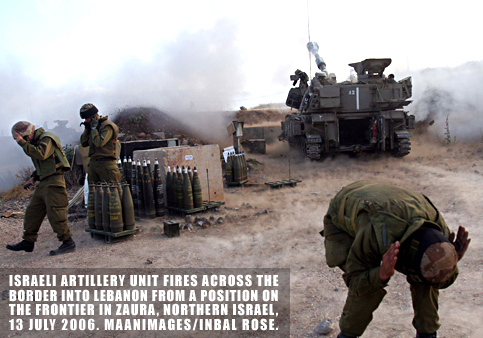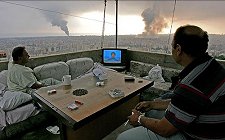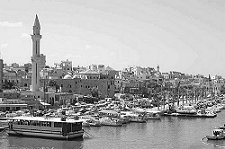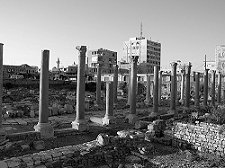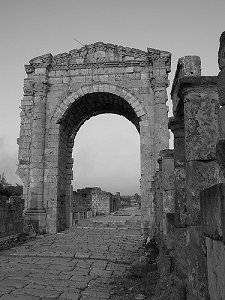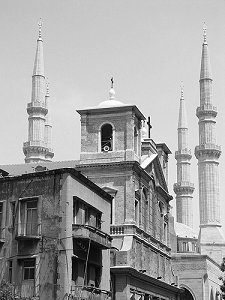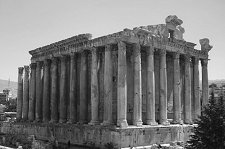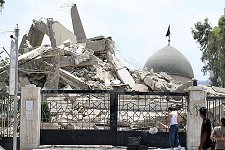Israel Attacks Lebanon (12 July 2006)
Lebanon for Beginners full article
Following the capture of two Israeli soldiers by Hizballah on July 12th, Israel brings its campaign of collective punishment and excessive use of force to Lebanon, with "Operation Just Reward". Dawn air strikes on south Lebanon on 13 July 2006 claimed the lives of at least 44 civilians, including over 15 children, and wounded over 100. Israel bombed bridges linking the north and south of the country and all three runways of Beirut's commercial airport. The Israeli army's Chief of Staff, Dan Halutz, promised that "nothing is safe in [Lebanon], as simple as that."
Lebanon for Beginners
Laurie King, Electronic Lebanon, July 2006
For many Americans, the names "Lebanon" and "Beirut" have long been synonymous with violence, chaos, terrorism, hostage-taking, and anti-US organizations, ideologies, and activities. These place names are often bywords for a total breakdown of social, political, and legal order. Indeed, the noun "Lebanization" has been applied to numerous situations of internecine ethnic conflicts played out in urban settings. Countering such conventional perceptions, this introduction to recent Lebanese history argues that even during the worst phases of Lebanon's multidimensional wars (usually fought in and over Beirut) order and patterns were evident in the structures and levels of confrontation: local, national, regional, and international.
Multiple strategies, sometimes in concert, though more often in competition, shaped the dynamic sociopolitical context of Lebanon over a period of sixteen years. As the war progressed, fighting became protracted and a war system was institutionalized, giving rise to a new class of warlord/politicians and nouveaux riches decision makers. Beirut was dissected socially and devastated physically. The post-war era witnessed remarkable rebuilding and sustainable reconciliation, but insufficient institutional and legal reforms.
Lebanon's war years were destructive and seemingly endless. By the late 1980s, a paralytic situation obtained: no one side could decisively win or lose on the military level. On the socioeconomic level, most Lebanese were unequivocally losers. On the political level, the Lebanese war, despite its monotonous logic of internecine violence, gave rise to dramatic developments in the form of new players, tactics, ideologies, and alliances. Even seasoned Middle East observers were taken by surprise at the latter developments, most clearly demonstrated by the emergence of the radical Shi'i militias, Islamic Jihaad and Hizbullah (Party of God), also known as the Islamic Resistance (al-muqaawamah al-islaamiyyah). These new political and military actors were born of local and regional events: the 1982 Israeli invasion of Lebanon and the 1979 Islamic Revolution in Iran.
Although Lebanon exhibits a number of unique sociopolitical characteristics, to be discussed below, its contemporary history cannot be understood outside of the larger historical, sociological, and political context of the contemporary Middle East.
The formation of ethnic groups in the Middle East, as well as the dynamics of collaboration and competition among such groups and between these groups and the states in which they are situated, arise from ever-changing balances of power and shifting frameworks of decision-making and resource distribution at the local, national, regional, and international levels. Such political processes are present in every region of the world, but in the Middle East, long a "cross-roads" linking diverse cultures, languages, economies, and environments, political phenomena and processes arising from the cross-fertilization of diverse peoples have always been pronounced. Since ancient times, and indeed, up until the present moment, the region has been a key prize for various world powers, from the ancient Roman and Persian empires, to the European colonial powers of the nineteenth and early twentieth centuries, and ultimately, to the multinational corporations and high-tech Western armies of the present era.
Thanks to its marked strategic importance, the Middle East and its people are no strangers to the intrigues and interventions of local, regional, and global politics. The most harrowing episodes of interethnic conflict in the Middle East have occurred when all three dimensions of competition for political power and economic resources -- global, regional and local -- have coincided, as they did in Lebanon during its long and bloody civil war, which was also a regional war fought out on Lebanese soil.
Defining the Terms
The Middle East or Near East has been characterized as such in relation to the Far East (China, Southeast Asia and Japan), indicating that the vantage point for determining these locations was not indigenous, but rather, Eurocentric. The perspective from which this label was coined was that of Britain and France, the former colonial powers. Here, we find an initial -- and telling -- indication of the historical tensions and conflicts surrounding issues of identity and power in the Middle East: the region has been defined and represented from the outside, not from within. This troubling reality has sparked various nationalist and religious movements over the years desiring to assert regional or national autonomy from Western political and cultural domination. Even many decades after the end of colonial rule, Western interests and interventions can still evoke deep emotions and great controversies.
The West's direct or implicit role in some of the continuing tensions and injustices in the region, particularly those associated with Israel's occupation of Palestinian territory and Israeli military attacks on Lebanon, or the US role in Iraq and the current militarization of the Arab Gulf region, are interpreted through a lens of suspicion, outrage, and anger. Ironically, although direct colonial rule long since ended, the dynamics of the current global capitalist economy and the Middle East's weak role therein replicate relationships of dependency between the region and the leading industrialized nations of the West.
The imperialist roots of the region's geographical labeling notwithstanding, the Middle East is conventionally described as stretching from Morocco and Mauritania in the west to Iran in the east, and from Turkey in the north to Sudan in the south. The area of this large and culturally diverse region, which is double the size of the continental United States, encompasses territory on three different continents (Africa, Europe, and Asia), and is home to over 370 million people, among whom Muslims constitute 82 percent of the population, Christians 9 percent, and Jews 7 percent. The region also includes other religious groups that do not fit neatly into the categories of the three monotheistic faiths, such as followers of the Druze faith, adepts of the ancient Zoroastrian faith (found in Iran and India), and followers the relatively new Baha'i faith that first originated in Iran, where it is now brutally repressed.
Since the newly-formed states of the region did not emerge as a result of long-term, organic economic and political processes, but rather, from the quick sketching of colonial powers' pens, few Middle Eastern states' boundaries coincided with pre-existing geographic, linguistic, riverine, or cultural borders (Egypt, Turkey, and Iran are the only exceptions). Consequently, a variety of identity crises and ethnic conflicts were built into the new states -- and thus into the new regional state system -- of the post-colonial Middle East from the outset. The crisis of national integration has been a continuing theme in the region, expressed through various permutations: military coups, politicized religious movements, strict language policies, and the sedentarization or transfer of population groups that posed direct or indirect challenges to the legitimacy of state borders or the control of state resources.
While few states in the Middle East can boast ethnic, linguistic, or cultural homogeneity, nearly all have tried to achieve it, some by force, particularly in the Sudan, and usually at the expense of weaker ethnic groups. The first and most horrific expression of ultra-nationalism in the region was the Turkish genocide of the Armenians in the second decade of the 20th century. The second was Israel's destruction of Palestine.
Socio-economic dimensions
Although fabulous oil wealth can easily be found in the Middle East, particularly in the countries of the Arab Gulf (Saudi Arabia, Kuwait, Qatar, Bahrain, the United Arab Emirates, and Oman), the vast majority of Middle Eastern people are more familiar with poverty or the fear of its imminent arrival. The gap between the region's haves and have-nots is profound, dramatic, and deepening. Perceived and actual economic inequalities influence the formation and mobilization of ethnic groupings, particularly in those countries in which the rich and poor live in close proximity, such as Lebanon, Egypt, and Turkey.
A growing economic trend throughout the region as a whole is massive rural-to-urban migration, imposing potentially dangerous social, economic, infrastructural and environmental strains on "mega-cities" such as Cairo, Istanbul, Khartoum, Beirut, Amman, and Tehran, which have populations ranging from two to fourteen million and suffer from resource scarcity, environmental degradation, and insufficient employment opportunities for the largely young, male, unskilled masses continuously flowing into their bursting metropolitan boundaries.
In assessing ethnicity in any region, including the Middle East, we must avoid the easy assumption that ethnic differences are essentially physiological differences. Ethnic differences are also class differences. The assumption that ethnic groups are determined primarily by objective biological criteria such as hair, skin, and eye color, or height and physique, and only further distinguished by such characteristics as language, cultural patterns, and religious faith, has facilitated racial stereotyping and racism in many societies. Social scientists examining the phenomenon of ethnicity stress that it is a strategic, more so than a genetic, phenomenon.
Ethnic identity, whether defined according to subjective criteria (an individual's awareness of and feelings about his or her membership in a particular ethnic category), or objective criteria (others' categorization of an individual on the basis of physical, cultural or linguistic characteristics), cannot exist in a homogeneous society in which everyone shares the same cultural, religious, class, and linguistic background. Ethnicity and ethnic identity are oppositional or dialectical phenomena; they only emerge in societies comprised of different types of peoples from a wide variety of backgrounds. Ethnicity is everywhere a feature of plural societies characterized by cultural, economic, linguistic or religious heterogeneity and inequalities of class, wealth, privilege, and access to resources.
With increasing migration from rural to urban areas and the impact of enhanced communications and transportation systems, individuals and groups from a wide variety of cultural, linguistic, socioeconomic, and religious backgrounds have suddenly been brought into contact with each other throughout the developing world. In the rapidly expanding cities of the Middle East, various ethnic groups interact and compete with one another in new and frequently alienating sociopolitical contexts characterized by economic scarcity and uneven development.
The recognition of ethnic differences thus implies the recognition of economic and political differences as well. The ensuing awareness of relative and absolute economic disparities can easily lead to conflict, competition, and opposition organized along ethnic lines.
Identity as a function of administrative regimes
Identity is neither programmed nor pre-existing; it is constantly being shaped by the interplay of contexts and the dynamics of power inherent in such contexts. If identities were determined by virtually immutable genetic realities alone, then we would expect to see the same categorizations, symbols, and expressions of identity enduring over time in the same place, regardless of economic, cultural, or political developments. This is clearly not the case in the Middle East, a region that has experienced rapid metamorphoses from empire to colonial regimes to modern nation state structures in less than a century, and in which organized ethnic and religious groupings have emerged in different periods to compete for power, resources, and privileges, thus highlighting the contingency and relativity of identity.
Under conditions of empire, familial and confessional (sectarian) identities were most significant in the region. Under conditions of centralized state administrations, new regional, class, cultural, and ethnic identities -- and consequently, new conflicts -- have come to the fore as laws and policies imposed identities on people that were new, uncomfortable, and even, in some cases, objectionable. A dual dynamic of identity is evident in the context of the modern nation state in the region. One aspect of this dynamic is that identities can be claimed actively by people affiliating as members of a particular group in order to mobilize efforts to secure access to scarce resources or threatened rights, or in competition with other groups for control of the state's resource distribution mechanisms.
The opposite aspect of this dynamic is identification as an involuntary process, as in those situations in which the state, desiring to safeguard or project a vision of its own ethnic purity or religious unity, imposes limited and limiting identities from above while forbidding the expression of contradictory identities from below.
Contexts and Catalysts of Ethnicity in the Middle East
The peoples of the Middle East are no strangers to harsh and uncertain environments, whether natural, economic, or political. Inhabiting an ecological zone characterized by aridity, steep valleys, rugged mountains, few rivers, scant rainfall, and poor soils, Middle Eastern communities were traditionally compelled to combine a variety of modes of subsistence, or mixed economies, such as pastoral nomadism, small scale agriculture, commerce and fishing, in order to make a living. Groups dwelling in this arid and semi-arid region also developed distinctive cultural patterns and sociopolitical institutions that served to minimize the hardships and uncertainties of their natural environment.
Up until the present era, the peoples of the Middle East have remained justly famous for loyal attachment to their families and religious communities, distinctive rituals of hospitality and conflict mediation, a preference for shifting and fluid coalitions rather than enduring, corporate socio-political organizations, and flexible kin-based collectivities, such as the lineage and the tribe, which until quite recently performed most of the social, economic, and political functions of communities in the absence of centralized state governments.
Prior to the advent of the nation state system, and even before the colonial era, most of the peoples of the region (with the exception of those living in Morocco, Mauritania, and Iran) lived under Ottoman rule in the sociopolitical framework of a vast and multi-ethnic Islamic empire. Day-to-day matters of administration and basic governance were overseen and discharged by local political elites chosen by the Ottoman rulers, as well as the local clergy. The Ottoman Empire was organized not according to ethnic or national principles and categories, but according to religious distinctions. Subjects of the Ottoman Sultan did not identify themselves as Ottomans, Turks, Arabs, Azeris, Berbers, or Kurds, but rather, as Muslims, Christians, Jews, and Druze. The crucially distinguishing social categories were religion, class, and gender.
Within this socio-political setting, Muslims constituted the majority, both in terms of absolute numbers and in terms of power, rank, status, and opportunities. Christians and Jews were formally recognized as respected religious minorities -- "Peoples of the Book" -- and categorized as dhimmi communities (literally meaning "on the conscience" of the larger and more powerful Muslim community). Christians and Jews were to be protected from harm or persecution by the majority Muslim community in return for their acceptance of a subordinate social and political status, payment of a special head tax (jizya) in exchange for their exemption from military service, and refraining from any public display of their religions, such as processions and liturgical ceremonies.
Dhimmi communities were under the jurisdiction of Islamic courts in the event of criminal cases and some property disputes, but otherwise obeyed the jurisdiction of their own communities' religious laws and precepts concerning any issues touching upon religious and family matters. As non-Muslims, Christians, Druze, and Jews were not subject to the rulings of shari'a (Islamic law) in matters of personal status such as marriage, divorce, inheritance, adoption, and other family issues. Instead, Christian sects and Druze and Jewish communities sought guidance, mediation, and rulings from their own religious leaders, who had the power to make binding judicial decisions in the domain of family law and to represent their religious communities in official dealings with the Ottoman authorities. This system of legally recognized, non-Muslim communal autonomy was known as the millet system (meaning "people" or "community" in Turkish).
The Middle East's cultural heterogeneity stemmed from geography as much as from Ottoman social categorizations, however. The ecological characteristics of the region, combined with the prevalence of rugged mountains, deep valleys, and virtually impassable desert expanses, compelled different communities to live in small, close-knit, family groupings widely separated from each other and unlinked in any overarching political or economic organization. This facilitated pronounced diversity in the region. For example, the three key cities of present-day Iraq, all of which are linked by rivers (Mosul, Baghdad, and Basra) had completely different systems of weights and measures and currencies until the late 19th century.
During the Ottoman era, the rugged mountainous areas of the Eastern Mediterranean became a refuge for a variety of Christian sects and Islamic splinter groups seeking to escape persecution by orthodox religious authorities. Dwelling high atop these mountains, minority groups such as the Maronites, Druze, Shi'a, and Alawites could pursue their religious traditions free of interference from either Christian or Muslim authorities. Religious refugees thus rendered the mountainous zones of the region culturally and religiously diverse: Not only the mountains of Lebanon and Syria, but also the mountainous regions of northern Iraq and Eastern Turkey, as well as mountainous regions of North Africa, have traditionally been home to minority groups such as the Kurds, Assyrians, and Berber tribes.
Middle Eastern cities have always evidenced cultural and religious heterogeneity. The plural nature of Middle Eastern urban space is inscribed in the very towers, walls, and gates which marked off the various named quarters of traditional urban settlements, e.g., "the Muslim Quarter," "the Armenian Quarter," the "Jewish Quarter," the "Orthodox Quarter," etc., as we find in such ancient cities as Jerusalem, Cairo, Damascus, and Baghdad. The spatial separation of different religious and ethnic groups in the traditional Middle Eastern city was paralleled by a division of labor between these distinct communities.
Muslims, Christians, and Jews occupied different professional categories in the Ottoman social and economic structure. The traditional city's division of labor was usually characterized by accommodation, complementarity, and integration rather than by competition and conflict. Muslims held influential positions in religious courts and schools as well as in the military and in local governmental administration, while non-Muslims served primarily as doctors, merchants, advisors, artisans, and religious and legal specialists for their own sectarian communities.
The Ottoman-era division of labor is recorded to this day in the names of many Christian families from Lebanon, Palestine, and Syria designating the professional and artisan roles that their ancestors played in Ottoman society, e.g., sabbagh (dyer), hakim (doctor), khabbaz (baker), sayigh (goldsmith), hayek (weaver), najjar, (carpenter), khoury (priest), and shammas (sexton).
The cultural and religious heterogeneity of the Middle East is thus neither a new phenomenon associated with rapid urbanization nor a function of the creation of nation states in this century. Nor is cultural diversity a byproduct of colonialism (although colonial powers certainly employed "divide and rule" tactics to consolidate their control of local societies and political systems under their rule). Different ethnic and religious groups have been living side by side in the Middle East for centuries, occasionally in conflict, but more often than not in harmony.
What is new is a transformed structure of relationships between different ethnic and religious groups within the contemporary Middle Eastern nation state. Here, we see the aforementioned interplay of context and ethnic identity: in the administrative context of the nation state, the social, political, and economic frameworks in which different groups interact, work, and struggle are no longer characterized by traditional guidelines of complementarity but by the uncertainties of competition. Although the Ottoman Empire was not an ideal model of economic efficiency or social justice, it nevertheless encouraged relations of intercommunal accommodation and cooperation to a greater degree than did subsequent colonial regimes or the imposed nation state system.
From empire to nation states
The relative balance and insularity of the Ottoman social universe was increasingly disturbed in the 18th and 19th centuries by European peoples, processes, and events. By the late 18th century, Ottoman authorities had grown alarmed by Europe's increasing military prowess and administrative efficacy, and accordingly attempted to copy European developments and practices so as to enhance their own control over the Empire's far-flung territory and resources. In the 19th century, Ottoman officials implemented a series of administrative and legal reforms, primarily to keep up with European advances, but partly to instill a sense of Ottoman identity and a renewed sense of order throughout the Empire.
Trade is frequently described as "the fig leaf of imperialism," and from the indigenous Muslim perspective during the last centuries of the Ottoman Empire, this was a valid assessment of increasing European penetration into the region. European commercial representatives set up agencies and field offices in such cities as Aleppo and Beirut, and close relations soon developed between Europeans and local Christian and Jewish merchants, artisans, traders and translators.
The non-Muslim communities of the Ottoman Empire benefited from these contacts and relationships not only economically, but also culturally and politically. By the middle of the 19th century, European powers were lobbying the Ottoman Sultan for better treatment and even protection of particular dhimmi communities, as well as special protections for European commercial agents and representatives in the region and for their local employees and contacts among the Ottoman Christian and Jewish population as well.
Under European pressure, the Ottoman Sultan issued a degree giving Christians and Jews legal equality with Muslims in the Ottoman Empire, just as the region's incorporation into a European-dominated market economy and the resulting transformation of the local economic system (particularly the shift from subsistence to cash crops) was having a noticeable impact on social and economic relations in the Ottoman world.
Muslim feelings of insecurity, inferiority, and victimization increased during this period of change, and were frequently expressed in attacks on the dhimmi communities. The most dramatic example was the massacres of Christians in the Shouf region of Mt. Lebanon and in Damascus in 1860, an event that increased French and British political and even military intervention in the region, eventually leading to the creation of a protected zone in Mount Lebanon at the instigation of European powers. This autonomous entity in Mount Lebanon, home to Maronites and Druze, was the embryo of the modern Republic of Lebanon.
European powers' concerns about the local non-Muslim population stemmed not from charitable impulses alone. Aiding and allying with local Christian and Jewish interests enabled European states to get their "foot into the door" of the declining Ottoman Empire. European actions in the Ottoman Empire were part and parcel of the "Great Game," the race among various European powers to control the routes to and the extraction of resources from the East, particularly India, where the British enjoyed -- and naturally endeavored to maintain -- a decided strategic advantage. In their pursuit of the "Great Game," the European powers backed different communities' interests, thereby establishing, whether by design or happenstance, the groundwork for the "divide and rule" policies so effectively implemented during the colonial period following the Ottoman Empire's collapse at the end of World War I.
During the colonial era, some groups received preferential treatment from the British and French authorities. The colonial policy of playing various groups off against one another was later echoed in the practices and policies of the new nation states that the colonial powers carved out of the region heedless of any coincidence of ethnic, natural, or linguistic borders. Those who had been favorites during the colonial era frequently became scapegoats after independence.
Lebanon in historical, political, and cultural context
Lebanon is a country marked by profound ethnic diversity because its mountainous terrain was historically so attractive to religious and ethnic minorities fleeing persecution. Lebanon's heterogeneity also stems from the manner in which it was patched together as an administrative territory following the collapse of the Ottoman Empire, represents a living remnant of the Ottoman millet system disguised as a centralized nation state. Lebanon began as the aforementioned autonomous region of Mount Lebanon that the French exacted from the Ottoman authorities in the 1860s to protect the Christian dhimmis (primarily the Maronites, an Eastern rite church that was always in communion with Rome and thus had more of a Western orientation than the other Christian sects). Before Lebanon's independence in 1943, the French colonial powers had attached to Mount Lebanon the northern regions of Akkar province, the city of Tripoli and its surroundings, the city of Beirut, and the southern cities of Sidon and Tyre. This deft carving of territories added Sunni, Greek Orthodox, Armenian Orthodox, Jacobite, Assyrian, and Shi'a communities to the largely Maronite and Druze communities of Mount Lebanon.
France's creation of the Republic of Lebanon did not sit well with Syrian leaders or the Syrian populace, who had always considered some of the new territories of Lebanon, particularly the northern provinces and the Beqa'a Valley, its territory. To this day, Syria, which plays an active role in Lebanese affairs, does not have an embassy in Beirut, the Lebanese Capital.
Adding to the mix of confessional groups in the newly forged Lebanese republic (which, at independence, was said to be 51 percent Christian and 49 percent Muslim by manipulations of statistical data) was the arrival in 1948 of tens of thousands of Palestinian refugees fleeing war and violence between Palestinian Arabs and European Jews who had been living and settling in Palestine since the last decades of the 19th century. After its establishment in 1948, Israel prohibited the return of the majority of the refugees who had fled or who had been forcibly driven out, in violation of UN General Assembly Resolution 194.
The arrival of Palestinian refugees in Lebanon presented not only a logistical and economic problem of immense proportions for a new state lacking in resources. The biggest threat posed by the refugees' presence was the potential demographic and political significance of a large Sunni Muslim group in a state dominated by Christians. Many Christian -- and even a few Muslim -- leaders of the new republic feared that the refugees might one day tip the delicate confessional balance and the verbal national pact that enabled Western-oriented Christians to coexist and collaborate with Muslims who looked to the Arab and Islamic world for their identity and ideological influences.
The Lebanese political system is based on confessional (sectarian) power-sharing (called "taa'ifiyya" in Arabic, from the word "ta'ifa," meaning "sect"). Lebanon is unique in being a country comprised solely of minorities -- 18 officially recognized ethno-confessional groups, to be specific. Each group has its guaranteed number of seats in the parliament, and each expects to receive its fair share of ministerial posts. The three largest groups -- the Maronites, the Sunnis and the Shi'a -- get the presidency, the prime ministerial, and the speaker of the parliament positions respectively. Theory and practice rarely coincide in politics, however, and the Maronite community's historic domination of Lebanon's political and economic power structures since before the state's establishment, no less than the context of relative and absolute deprivation and economic inequalities, rising regional Arab nationalist sentiments (particularly pro-Palestinian feelings), and the polarizing influences of the Cold War between the US and the USSR in the region, all led to the eventual conflagration of the war.
Sociological studies consistently emphasize that a minority is not necessarily defined in terms of demographic size, but rather, in terms of relative political and economic power, as well as by distinguishing cultural beliefs and attitudes. If a minority is a group that lacks power, it is only a short leap to the conclusion that a minority group is always a potential victim group.
In Lebanon, the entire population, being a mosaic of contending minorities, was thinking and feeling like potential victims even before the war broke out on April 13, 1975. It is no wonder, then, that the war was so violent, so bitter, and so protracted. Long before the war began, the Lebanese were enmeshed in a political and psychological "economy of scarcity" which left everyone feeling both vulnerable and opportunistic.
Clearly, many of Lebanon's eighteen different sects had valid historical, political, and economic reasons to worry about scarcities of power, security and resources. Taa'ifiyya, however, actually obstructs power-sharing at the grass-roots level and gives rise not to a nation of fellow citizens, but rather, to an arena of pronounced conflict and competition between many anxious and agonistic minority groups. Because of Lebanon's confessionally based system, every individual is encouraged to think of himself or herself as a Maronite, a Shi'i or a Sunni first, and only secondarily as a Lebanese citizen. By emphasizing the group over the individual (and thereby minimizing the individual's choice, power, and sense of responsibility), and by privileging the sect over the state (thus contributing to the fragmentation of the polity), ta'ifiyya cannot but set the stage for future conflicts.
Not only has Lebanon's system of confessional power-sharing had detrimental effects on national identity and the consolidation of the institution of citizenship, it has also complicated Lebanese conceptions, attitudes and behaviors associated with power. In Lebanon, power is not vested in the individual; rather, individuals can only attain power through their community, or, more specifically, through the leader (za'eem) of their community, who usually wields absolute power (backed-up by credible threats of force) in the context of his confessional group. The concentration of power in the hands of a few individuals in Lebanon's political system has increased the sense of powerlessness and dependency which are already so prevalent among the members of each of the country's contending minority communities.
The institutionalization of ethnic and religious identities for legal and administrative purposes, seen most clearly in states such as Lebanon and Israel, is a double-edged sword. Although official recognition of cultural heritage and religious laws may provide answers to individuals' psychological needs and communal organizational problems, it can also trap individuals (particularly women) in the vise of inflexible identity categories not of their own choice or making, thus limiting their personal options and opportunities while preventing the development of a more inclusive sense of overarching national loyalty and identity.
Political and Historical Background of the 1975-1990 Lebanese War
During the 1950s and 1960s, Lebanon was celebrated as "the Switzerland of the Middle East." Beirut, a vibrant Levantine crossroads of cultures, was home to over a million Lebanese from 18 different ethnoconfessional sects, thousands of Palestinian refugees, Arabs fleeing tyrannical regimes, and many European and American families working for ARAMCO and its subsidiaries.
A regional center for banking, finance, insurance, and import-export trade, Beirut meant very different things to the wide variety of people who lived in her neighborhoods or passed through her streets en route to other destinations. For middle class Arabs in Lebanon and throughout the region, Beirut was a glittering modern capital: sitt ad-dunya, "The Lady of the World" -- the center of Middle Eastern sophistication, luxury, cosmopolitan attitudes, fashions, and pleasures. For Arab intellectuals and aspiring politicians, Beirut offered a welcomed breathing space for discussing, publishing, and actualizing ideas deemed radical or revolutionary elsewhere. For the wealthy from east or west, Beirut was "Paris on the Mediterranean," site of a vibrant and lucrative services industry, deluxe casinos and hotels, and the best hospitals and universities in the Arab world.
Yet Beirut was also a troubled zone of tragic contradictions and painful contrasts: between the ostentatiously wealthy and the miserably poor, citizens and refugees, secularists and religious, Left and Right, Orient and Occident.
Although Beirut has been continuously inhabited for millennia, it was not until the 20th century that the city became demographically and politically significant. The name "Beirut" has either Syriac, Hebrew, or Phoenecian roots, meaning "wells" or "many wells," indicating that this flat triangular plain, which juts into the Mediterranean and enjoys a natural harbor, has always been rich in fresh water sources other than those provided by rivers and snow melts descending from the mountainous regions to the city's south and east (the Shouf region and Mount Lebanon, respectively).
Beirut grew dramatically during the latter half of the 20th century. A middling port town and trading center that took on added importance with the rise of the silk trade in the 18th and 19th century under Ottoman rule, Beirut's population was predominantly Sunni Muslim and Greek Orthodox.
Although Lebanon is conventionally described as multi-confessional, it is primarily in the capital, Beirut, where all of the country's 18 sects actually lived in proximity to one another and shared the same sociological and infrastructural field of interaction and lived and worked in the same physical setting. Beirut was the living embodiment of Lebanese confessionalism, in all its rich cultural and interpersonal potentiality, artistic and literary expression, cosmopolitan attitudes, and fertile ideological and intellectual trends, as well as its implicit tensions, disjunctions, and contradictions. Opportunities and dangers co-existed in the sociopolicical fabric of Beirut; external actors and influences could easily encourage one or the other dimension to flourish.
What makes a city a city is not the number of people who live there, or the existence of different classes, ethnicities, lifestyles, or occupations, but rather, the nature of social role configurations and most crucially how social roles are combined to create new social formations that highlight personal networks, informal structures, diverse role domains that do not necessarily overlap, and various roles that one individual may play in a single day. The militarization and mobilization of distinctively urban networks was key to the carnage visited upon Beirut from 1975-1990.
One Urban Setting, Multiple Levels of Confrontation
The Lebanese war, largely (but not entirely) played out in and through the urban fabric and infrastructure of Beirut, was in fact three overlapping, interpenetrating and dynamically interacting wars:
1. A civil war to influence and alter power sharing within Lebanon among Christians and Muslims. This dimension of the war centered on tensions within the official system of confessional power sharing (at-taa'ifiyya, which had grown unworkable as Muslims began to outnumber Christians. As historian Ussama Makdisi notes in an incisive study of the roots of confessional conflict in Lebanon, sectarianism is not an ancient and deeply rooted identity system. Rather, it first appeared as a thoroughly modern response to jarring, internal and external changes in the mid-19th century Ottoman Empire. Confessionalism, like ethnicity, is about contests for power in uncertain settings, usually urban settings. It is not a genetically transmitted mentality or an ineluctable set of traits. Makdisi further observes that "The war in Lebanon ended, but sectarianism did not." To dismantle sectarianism, he urges us to look not at religion and culture, but rather to attend to political and economic realities as well as local conceptions and practices of power in their articulation and interaction with regional and global political configurations. Confessionalism is grounded in globalization, not tribalism; it is a correlate of processes of modernity, not ancient history. At its birth, Lebanon was anchored in a "gentleman's agreement" between the country's Christian and Muslim political leadership, who represented families and regions, not individuals: Lebanon would be a Christian country with an Arab face, in which Christians would not turn to the West and Muslims would not turn to the Arab world, but rather each group would negotiate and coordinate with each other to create a special balance in which a multi-ethnic sociocultural and political space would be viable on the shores of the Eastern Mediterranean. The breakdown of this agreement, known as the "National Pact," had actually preceded the war, but was hastened by the second dimension of Lebanon's war;
2. A regional Israeli-Palestinian-Arab war to determine the configuration of power, identity, and influence in the region. This dimension had begun, in fact, with the fall of the Ottoman Empire and the overt influence of European colonial powers in drawing up the borders of the region's new nation states, a political process that assumed special poignancy in Palestine with Great Britain's promise of the same land to two different peoples. Before the inception of Lebanon's war years, the regional dimension of battle, one expressive of primordial and powerful existential fears of all parties, was largely fought out in and around Palestine and Israel, and usually in the form of dramatic, though short-lived, conventional warfare on battle fields (1948, 1967 and 1973). With the PLO's adoption of Lebanon as its "administrative center" in the early 1970s, and its increasing use of Lebanese territory as a staging ground for attacks on Israel, rationales were readied for Israel's 1978 and 1982 invasions of Lebanon, both of which involved wider, unvoiced strategies to secure Israel's hegemonic position in the region. The 1982 invasion caused the most intensive and extensive physical damage and loss of civilian life, altered the course of the war, deepened political dilemmas for all parties, including the United States, and revealed the extent and dangers of the third dimension of Lebanon's war;
3. The international dimension, which was implicit from the start, given Lebanese connections to both the West and the Arab-Islamic world. Lebanese are inveterate labor migrants, and economic ties between Lebanon, the Persian Gulf states, Western and Central Africa, and North and South America played a role in political lobbying, remittance income, and arms dealing from the start of the war. France, the former colonial power, had intense interests in Lebanese developments, as did the Vatican. Israel and the US were anxious about radical Arab nationalist and Palestinian tendencies in Lebanon. After 1979, and especially after the 1982 Israeli invasion and its bloody aftermath, the Islamic Republic of Iran became a key player in Lebanon. Though political scientists of the 1980s viewed US-USSR confrontations through various proxies in Lebanon as significant, in retrospect, it was the emergence of urban warfare between Western and Islamist groupings that signaled new and evolving international dimensions of conflict in Lebanon and the region.
The multidimensionality and dynamism of the Lebanese conflict was not new, however. Beirut's tensions were beginning to take on regional and international shades of meaning and tension as early as the mid-1950s. Conflicts in the Arab world, coupled with the US-USSR confrontation, certainly colored Lebanon's short-lived though scarring 1958 disturbances. These same conflicts reverberated much more loudly and lethally two decades later, not only because of international developments, but even more so because of social, economic, and political realities within Lebanon, concretized in the urban landscapes and social formations of Beirut.
The "poverty belt" (hizaam al-fuqr) or "misery belt" (hizaam al-ya's) housing Beirut's poor continued to grow during the 1960s, generating its own informal economic and social constellations, based largely on kinship and confessional networks. The weak Lebanese state provided scant assistance to the marginalized poorer classes of Lebanese and Palestinians, so informal family and sectarian networks and patron-client relationships assumed added importance. This ensured that particular families dominated various businesses as well as public and private economic sectors. Residents of the poverty belt formed the bottom ranks of the work force of the port, factories, and the tourism sector of Lebanon's economy, and enjoyed political representation through ethnosectarian and/or trade union organizations. By the war's end, the latter had waned and the former had waxed.
The poverty belt was to provide a natural constituency for a variety of political resistance groupings and militias during the war. By the late 1960s, the residents of Beirut's "shantytowns" were very receptive to the revolutionary messages of the Palestine Liberation Organization, which had relocated its infrastructure, leadership, fighters and funds to Beirut from Amman in 1970-71.
Beirut's faces were many. Identities, interests, goals, affiliations, and perspectives were always plural and subject to rapid changes and shifts in emphases and directions. Multiple modes of organization and frames of meaning made the city intriguing and attractive to outsiders, exciting and charming to its residents, and perplexing to invading or occupying armies. That the city became the stage for local, national, regional, and international confrontations is not surprising. As native Beirutis would sigh each time a new round of fighting or shelling began: Beirut mal'ab duwwali ("Beirut is an international playing field"), a convenient military venue, given its open political and literary culture, its coastal geographical location, and weak state structure, for various actors, formal or informal, state or non-state, who might have a bone to pick or an agenda to pursue.
Even now, more than a decade after the end of Lebanon's 1975-1990 civil war, many Lebanese refer to this dark period as harb al-aakhireen, "the war of others" on Lebanese soil. This characterization is only partly true, however. It was a war co-created and co-ordinated by Lebanese and others -- Syrians, Palestinians, Israelis, Americans, and Iranians.
Like other cities of the Middle East, Beirut has witnessed dramatic and rapid processes of urbanization, profound class disparities, and the ensuing psychosocial dislocations and alienation that often result. The organizing principle of any city is that of administrative and economic centralization, consolidation of authority, and redistribution of resources, all of which serves to impact and restructure rural areas in their relationship to urban institutions and processes. The long war in Lebanon gradually reversed and subverted all of these processes: Fragmentation replaced centralization, duplication of economies replaced a formal redistributive economic structure as various militias claimed public facilities, such as ports, for themselves and their community, exacting high taxes and custom duties to fill their coffers, and supplementing this income with illegal activities such as drug and arms sales, protection rackets, and outright robberies.
Pluralism and heterogeneity, the urban mix that makes or breaks a successful city, was banished during the war. The logic of the militias was the logic of cantonization. Beirut's division had its echoes in other Lebanese cities and villages, where fighting and massacres often led to the influx of more villagers into those parts of the capital controlled by "their" co-religionists' militias.
Territory became identity, and identity was ineluctable in the war. In the absence of a state structure and a centralized government, familial and religious networks, and the patron-client relationships linking neighborhoods, cities, regions, and transnational settings and actors, assumed pronounced importance, power, and utility. These networks probably enabled many Lebanese to survive the war, and certainly played a role in keeping the Lebanese economy surprisingly vibrant and resilient from the start of the war until 1983, but these networks also fragmented Lebanon as a nation, and were especially evident in the fracturing of Beirut.
Western commentators often malign diverse social settings such as Beirut and Baghdad as fertile terrain for ethnic conflict and intercommunal violence. It is not, however, the presence of diversity itself that results in political tensions. Rather, it is how various communities are related to one another politically and economically, how they are encapsulated and incorporated into larger political and economic relationships, and whether those relationships are respectful of individual and collective dignity or not, that leads to conflict. Listening to the voices, experiences, and views of people in such diverse settings is crucial for debunking currently popular theories claiming that "clashes of civilizations" are inevitable, and for countering those who speak cavalierly of an "Arab-Islamic exceptionalism" that inevitably derails democratic systems of governance.
Such simplistic observations devoid of cultural contextualization can easily fuel narrow perspectives that slight historical and geostrategic considerations, the problematic, external imposition of the nation-state as an administrative framework in this region, and the dynamics of the global political economy, pinning all political failures instead on "essential cultural predilections" of Arabs and Muslims for tyranny and repression. The role of outside interests and actors, and the way their interests and aims dovetail with those of Lebanese actors, must be fully considered in any analysis of Lebanese politics.
|

